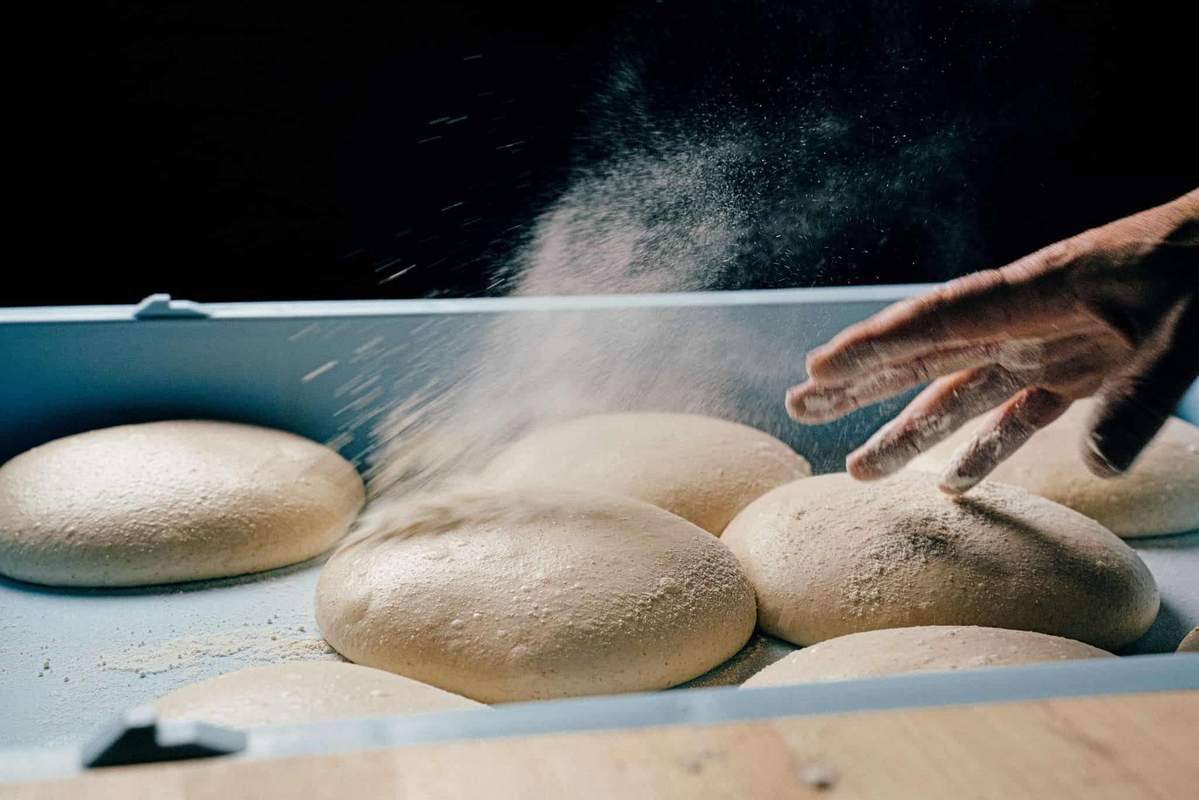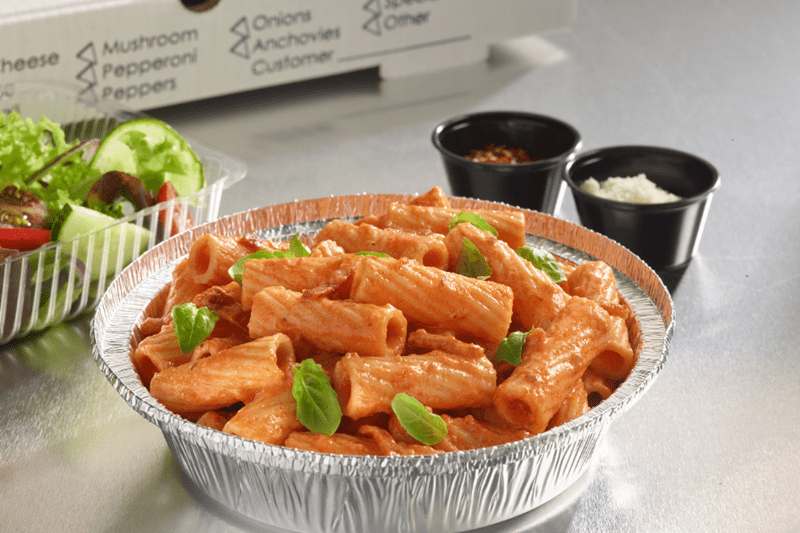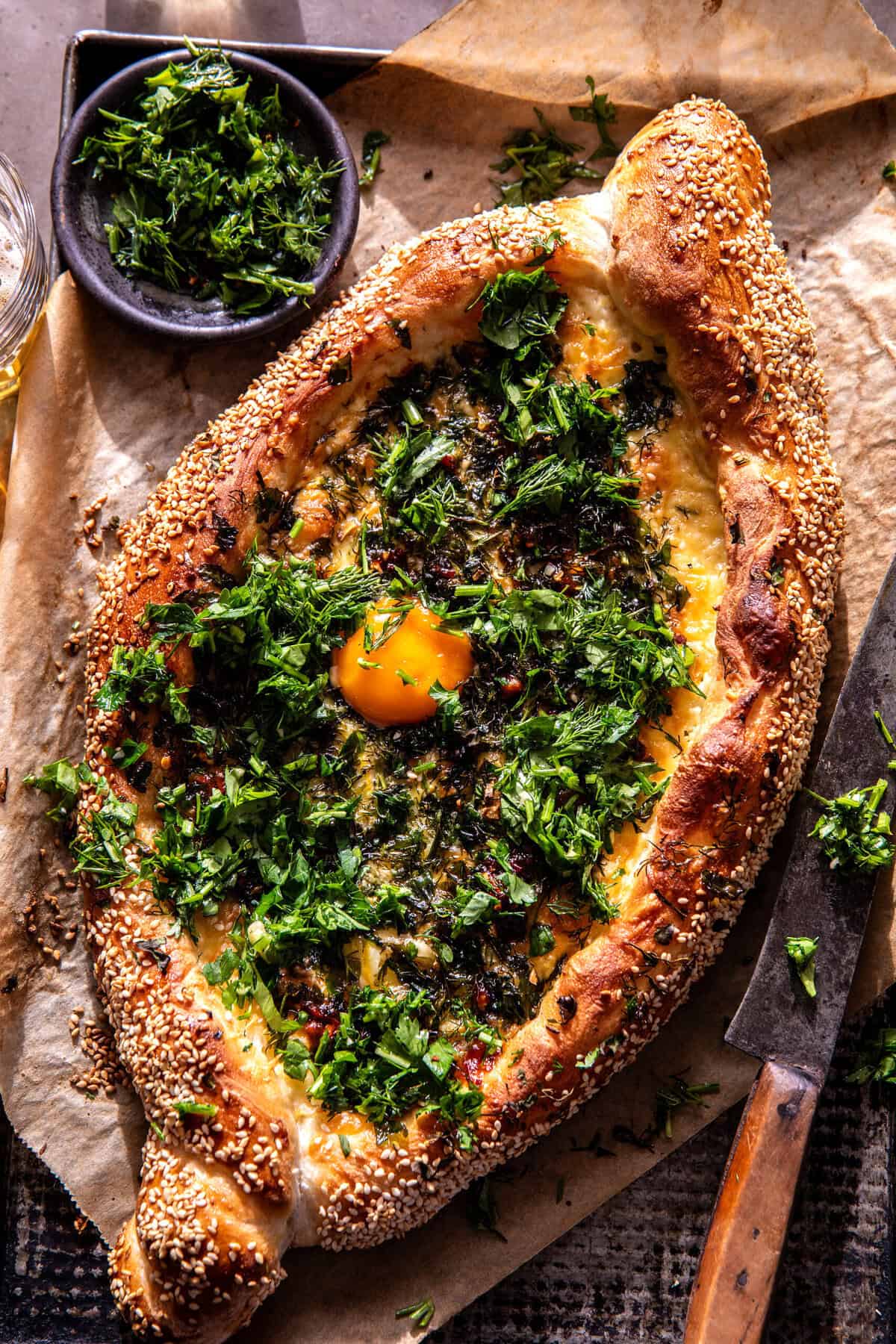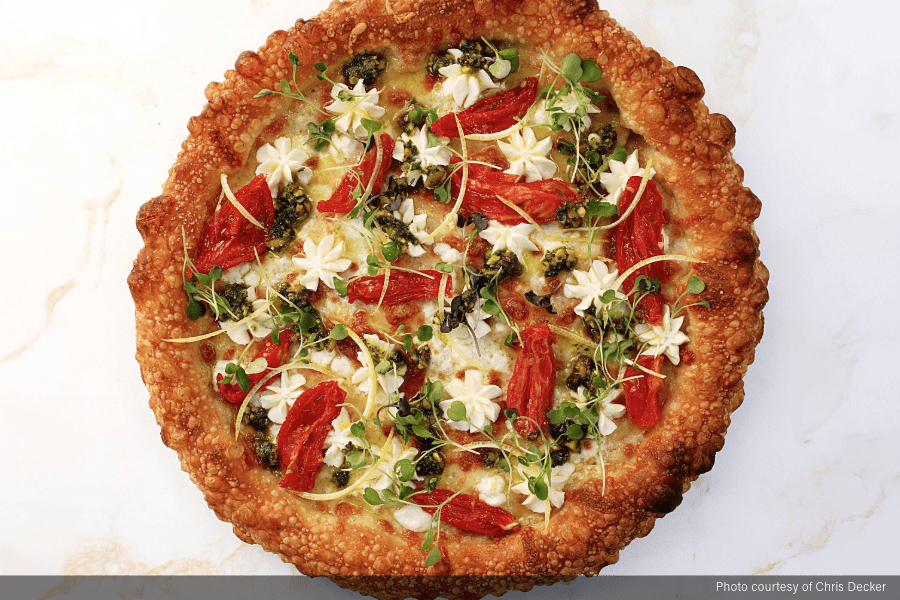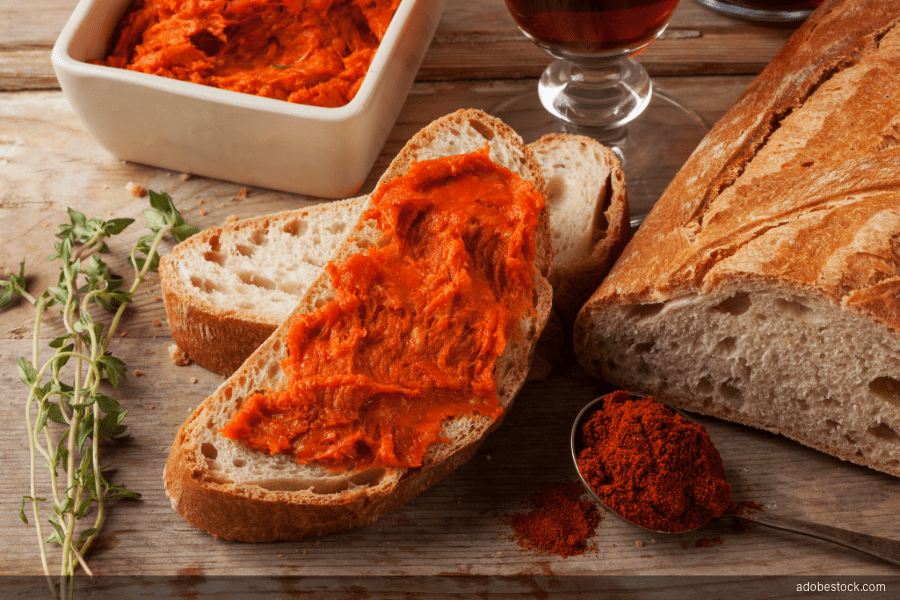Since opening in 2012, Razza Pizza Artigianale in Jersey Metropolis, New Jersey, has taken critics by storm. Its old-fashioned and full of life strategy to pizza is because of the proprietor, chef Dan Richer, whose obsession with artisanal Italian pizzas burns as sizzling because the wood-fired ovens he makes use of to prepare dinner them. From the homegrown yeast tradition to the cherry-picked, regionally sourced elements that adorn every pizza, every thing at Razza is produced with intention. For those who’re unable to go to, concern not: Richer’s new e book, The Joy of Pizza, written in collaboration with Rome-based meals journalist and creator Katie Parla, is aimed toward inspiring dwelling cooks to achieve for a similar requirements.
To have a good time the discharge, Dan and Katie have kindly shared a number of of their favourite recipes from the e book, beginning with this one. Dan’s On a regular basis Dough is a recipe so versatile, it stretches past the confines of pizza: ciabatta, English muffins, and even boule loaves can all be created utilizing this identical methodology. Made with white flour and industrial yeast (Dan prefers the Saf-instant brand), it’s accessible and easy. You should utilize any flour out of your native grocery store (no particular mix wanted) and nonetheless obtain the flawless outcomes Dan strives for utilizing his Pizza Analysis Rubric, the collection of meticulous pizza high quality checklists on which The Pleasure of Pizza is constructed.
Whereas we wouldn’t name this a newbie recipe — the tactic takes three days from begin to end — it’s a easy introduction to the craft of making and dealing with high-hydration dough, straight from the palms of a grasp. As soon as the preliminary mixing is completed, every of the steps previous to baking take 5 minutes or much less. The additional effort in your half can be rewarded by means of the wealthy taste of the ensuing dough. Dan believes this recipe is so particular partly as a result of it supplies coaching for beginner- and intermediate-level bakers’ palms and helps construct confidence in dealing with delicate, high-hydration dough. For those who’re curious about growing your skillset throughout pizza kinds, this recipe is a superb place to begin.
Excerpted from THE JOY OF PIZZA by Dan Richer with Katie Parla. Copyright © 2021 by Dan Richer. Images by Eric Wolfinger. Illustrations by Katie Shelly. Used with permission of Voracious, an imprint of Little, Brown and Firm. New York, NY. All rights reserved
Time
3 days complete, together with proofing time
Yield
Makes 7 balls weighing about 250 grams every
Tools
Electrical mixer with dough hook hooked up (optionally available)
Ooni Pizza Dough Scraper
Ooni Pizza Oven
Ooni Infrared Thermometer
Substances
35 ounces (1000 grams) “00” flour (100%)
1 teaspoon (3 grams) instantaneous yeast (0.03%)
3 cups (680 grams) water (68%) *If utilizing a traditional oven, enhance water to 760 grams, or 76% hydration
1 ½ tablespoons (20 grams) fantastic sea salt (2%)
Rice flour or fantastic semolina flour, for dusting
Notes: Dan recommends a dough temperature of 78°F (25.5°C). To work out the perfect water temperature for reaching this, use this formulation: (78°F x 3) − (Air Temperature + Flour Temperature + Friction Issue*) = Goal Water Temperature (°F).
*Friction issue is the warmth generated by means of the motion of kneading dough. The way you knead the dough can have completely different friction components, and due to this fact completely different dough temperatures: For those who’re mixing by hand, the friction issue can be near 0 (barely 1 or 2°F)
For those who’re utilizing a mixer, relying on the model, this will attain as much as 40°F. To work out the friction issue of your mixer for a particular batch measurement, first combine the dough, then take the dough’s closing temperature. Subtract the specified dough temperature (on this case, that’s 78°F) from the precise dough temperature, and the ensuing determine would be the friction issue for that mixer and batch measurement.
Technique
DAY 1
If mixing by hand:
Incorporate the elements: In a big bowl, combine collectively the flour and yeast. Add the water and blend along with your fingertips or a spoon till no dry bits stay.
Relaxation the dough: Put aside, coated with a clear kitchen towel, for 20 minutes to at least one hour to hydrate the flour.
Incorporate the salt: Uncover the bowl. Sprinkle the salt over the dough and use your fingers to scissor-pinch it into the combination. (Dan recommends utilizing your thumb and first finger to work the salt in from one facet of the dough to the opposite.)
Knead: As soon as the salt is included and dissolved, use 4 closed fingers (pinky to index) to combine with out tearing, then press the dough gently onto itself. Rotate the bowl a half flip and repeat. Subsequent, rotate the bowl 1 / 4 flip and repeat the lifting/urgent course of, then rotate one other half flip and repeat. The dough will tighten up and strengthen throughout this collection of stretch and folds.
Coated with plastic wrap or a clear kitchen towel and set dough apart at room temperature for an additional half-hour. Repeat the stretch and folds each half-hour. After 2 hours of bulk fermentation, the dough ought to really feel as if gasoline is increase inside. It must also go the windowpane check: Stretch the dough rigorously between your fingers and maintain it as much as the sunshine. For those who can see gentle by means of the dough, the gluten construction is robust. If the dough tears, relaxation it for half-hour, then carry out one other set of stretch and folds.
Cowl with plastic wrap and place within the fridge to relaxation in a single day. If it looks like there’s no gasoline manufacturing after 2 hours, set the bowl apart at room temperature till the dough has elevated by at the very least 20 % in quantity earlier than transferring to the fridge. In a single day, extra gasoline will develop.
If utilizing a mixer:
Within the bowl of a stand mixer fitted with a dough hook, first add 85% of the water, adopted by the flour and yeast. Combine on a low pace till shaggy, then relaxation, coated, for 20 minutes to an hour. Incorporate the salt and proceed mixing on a low pace till the dough is easy and stretchy. Slowly add the remaining water. As quickly because the water is absolutely included, flip off the mixer. Switch the dough to a really frivolously oiled container and observe the recipe process above from the majority ferment with stretch and fold steps.
Utilizing a mixer can scale back the whole variety of stretch and folds required to achieve the specified stage of gluten improvement, so you might solely have to do one collection. Bulk fermentation is full when the dough has elevated in quantity by at the very least 20 % and passes the windowpane check (see above).
DAY 2
The following morning (or at the very least 12 hours later), take away the bowl from the fridge and uncover. Stretch and fold the dough as soon as extra within the bowl; the dough will really feel noticeably stronger. Cowl with plastic wrap and return to the fridge.
Divide and spherical: Earlier than mattress (or at the very least 12 hours later), take away the bowl from the fridge and uncover. Flip the dough out onto a frivolously floured work floor, permitting it to softly launch from the
bowl. Deal with the dough with excessive care. Utilizing a dough scraper, reduce the dough into seven equal items weighing about 250 grams every. In case you are making a pan pie, reduce the dough into two equal items weighing about 890 grams every.
Working with one piece of dough, elevate the highest half of the dough (from 12 o’clock) and press it into the middle of the dough. Subsequent, elevate the underside half of the dough and press it into the middle. Take the left facet of the dough and elevate and press it into the middle. Repeat with the precise facet. Then, collect all 4 corners and pull and fold them into the middle of the ball, then gently press to connect. Don’t flatten. Make certain the ball is rounded and the underside is sealed, pinching it closed if vital. Gently flip the dough so the seam facet faces down. Repeat this course of with the remaining dough items. Place every ball into a person, very frivolously oiled plastic container giant sufficient for the ball to double in quantity. You may also place the balls on a frivolously floured dough tray or baking sheet, mud their tops with flour, and canopy with plastic wrap.
Proof: Switch the dough to the fridge to relaxation in a single day, or for at the very least 12 hours.
DAY 3
Carry the dough to room temperature: The following day, take away the dough from the fridge 2 to three hours earlier than you intend to bake and set it apart to achieve room temperature. The dough ought to have considerably elevated in quantity whereas within the fridge. If it has not, enable it to extend in quantity at room temperature earlier than baking. The dough can be prepared when it has elevated in quantity by 20 % and passes the poke check. (This implies it springs again slowly and leaves a slight indentation when poked.)
If cooking with an Ooni pizza oven: Purpose for 950°F (500°C), utilizing the Ooni Infrared Thermometer to rapidly and precisely verify the temperature of the baking stone.
If cooking with a house oven: Preheat your oven to its highest temperature. In case you have a stone or metal, place within the heart of the oven to preheat.
Stretch: Flour the highest of a dough ball. Whether it is inside a container, flip the dough out onto a generously floured floor. Whether it is resting on a dough tray or baking sheet, gently place your non-dominant hand ron prime of the floured dough ball, then use a dough scraper to scoop up the dough. Invert the dough and gently decrease it onto a generously floured floor. Attempt to not harm any of the dough’s construction, and be as minimally invasive as potential. Hold monitor of the “prime” and “backside” of the dough. (The highest of your future pizza is the facet at the moment dealing with the countertop.) Utilizing extraordinarily mild actions and retaining fingertips flat and unfold, apply stress on the dough at 10 and a couple of o’clock. Reposition your palms on the portion of dough nearest you. Transfer from the highest of the dough towards your physique, urgent downward and outward with every movement. Depart an inch alongside the rim untouched.
Flip the dough over. The highest of the long run pizza is now dealing with upward. Proceed stretching the dough, utilizing the method that works greatest for you. One strategy: Depart the dough on the counter and, with one hand within the heart, pull at 3, 6, 9, and 12 o’clock. You may additionally scoop up the dough from beneath, retaining your palms dealing with the counter, then flip it, stretching and pulling it in increments utilizing your knuckles. Be very mild and don’t be afraid to depend on gravity, that nice stretcher of pizza dough. No matter your method, stretch the dough till it reaches 10 to 11 inches in diameter. You’ll do one closing stretch as soon as on the peel.
Switch to the peel: Mud the peel with coarse rice flour and wipe your palms to take away any extra moisture. Gently scoop up the dough, sliding your palms beneath it with palms dealing with the work floor. Shake off any extra flour and switch the dough to the floured peel. Utilizing flattened and unfold fingertips, palms dealing with upward from beneath, gently pull the dough till the disc reaches 12 inches in diameter. Make certain your palms are dry while you do that, in any other case the dough will follow the peel.
Construct the pizza: Add your required toppings.
For the bake:
If cooking with an Ooni pizza oven: Slide the pizza off the peel and into your Ooni oven. Prepare dinner for 1 to 2 minutes, turning the pizza commonly to make sure it cooks evenly.
If cooking with a house oven: Slide the pizza off the peel and into your oven and onto the tray/metal/pizza stone. Prepare dinner for six to 7 minutes till the pizza is baked and browned, and the toppings are melted.
Dan suggests assessing your pizza in keeping with his “Pizza Analysis Rubric,” which supplies an in depth guidelines for pizza high quality —one which could be referred to, and improved upon, following every bake.
Repeat with remaining dough balls, slice, serve and revel in!
Since opening in 2012, Razza Pizza Artigianale in Jersey Metropolis, New Jersey, has taken critics by storm. Its old-fashioned and full of life strategy to pizza is because of the proprietor, chef Dan Richer, whose obsession with artisanal Italian pizzas burns as sizzling because the wood-fired ovens he makes use of to prepare dinner them. From the homegrown yeast tradition to the cherry-picked, regionally sourced elements that adorn every pizza, every thing at Razza is produced with intention. For those who’re unable to go to, concern not: Richer’s new e book, The Joy of Pizza, written in collaboration with Rome-based meals journalist and creator Katie Parla, is aimed toward inspiring dwelling cooks to achieve for a similar requirements.
To have a good time the discharge, Dan and Katie have kindly shared a number of of their favourite recipes from the e book, beginning with this one. Dan’s On a regular basis Dough is a recipe so versatile, it stretches past the confines of pizza: ciabatta, English muffins, and even boule loaves can all be created utilizing this identical methodology. Made with white flour and industrial yeast (Dan prefers the Saf-instant brand), it’s accessible and easy. You should utilize any flour out of your native grocery store (no particular mix wanted) and nonetheless obtain the flawless outcomes Dan strives for utilizing his Pizza Analysis Rubric, the collection of meticulous pizza high quality checklists on which The Pleasure of Pizza is constructed.
Whereas we wouldn’t name this a newbie recipe — the tactic takes three days from begin to end — it’s a easy introduction to the craft of making and dealing with high-hydration dough, straight from the palms of a grasp. As soon as the preliminary mixing is completed, every of the steps previous to baking take 5 minutes or much less. The additional effort in your half can be rewarded by means of the wealthy taste of the ensuing dough. Dan believes this recipe is so particular partly as a result of it supplies coaching for beginner- and intermediate-level bakers’ palms and helps construct confidence in dealing with delicate, high-hydration dough. For those who’re curious about growing your skillset throughout pizza kinds, this recipe is a superb place to begin.
Excerpted from THE JOY OF PIZZA by Dan Richer with Katie Parla. Copyright © 2021 by Dan Richer. Images by Eric Wolfinger. Illustrations by Katie Shelly. Used with permission of Voracious, an imprint of Little, Brown and Firm. New York, NY. All rights reserved
Time
3 days complete, together with proofing time
Yield
Makes 7 balls weighing about 250 grams every
Tools
Electrical mixer with dough hook hooked up (optionally available)
Ooni Pizza Dough Scraper
Ooni Pizza Oven
Ooni Infrared Thermometer
Substances
35 ounces (1000 grams) “00” flour (100%)
1 teaspoon (3 grams) instantaneous yeast (0.03%)
3 cups (680 grams) water (68%) *If utilizing a traditional oven, enhance water to 760 grams, or 76% hydration
1 ½ tablespoons (20 grams) fantastic sea salt (2%)
Rice flour or fantastic semolina flour, for dusting
Notes: Dan recommends a dough temperature of 78°F (25.5°C). To work out the perfect water temperature for reaching this, use this formulation: (78°F x 3) − (Air Temperature + Flour Temperature + Friction Issue*) = Goal Water Temperature (°F).
*Friction issue is the warmth generated by means of the motion of kneading dough. The way you knead the dough can have completely different friction components, and due to this fact completely different dough temperatures: For those who’re mixing by hand, the friction issue can be near 0 (barely 1 or 2°F)
For those who’re utilizing a mixer, relying on the model, this will attain as much as 40°F. To work out the friction issue of your mixer for a particular batch measurement, first combine the dough, then take the dough’s closing temperature. Subtract the specified dough temperature (on this case, that’s 78°F) from the precise dough temperature, and the ensuing determine would be the friction issue for that mixer and batch measurement.
Technique
DAY 1
If mixing by hand:
Incorporate the elements: In a big bowl, combine collectively the flour and yeast. Add the water and blend along with your fingertips or a spoon till no dry bits stay.
Relaxation the dough: Put aside, coated with a clear kitchen towel, for 20 minutes to at least one hour to hydrate the flour.
Incorporate the salt: Uncover the bowl. Sprinkle the salt over the dough and use your fingers to scissor-pinch it into the combination. (Dan recommends utilizing your thumb and first finger to work the salt in from one facet of the dough to the opposite.)
Knead: As soon as the salt is included and dissolved, use 4 closed fingers (pinky to index) to combine with out tearing, then press the dough gently onto itself. Rotate the bowl a half flip and repeat. Subsequent, rotate the bowl 1 / 4 flip and repeat the lifting/urgent course of, then rotate one other half flip and repeat. The dough will tighten up and strengthen throughout this collection of stretch and folds.
Coated with plastic wrap or a clear kitchen towel and set dough apart at room temperature for an additional half-hour. Repeat the stretch and folds each half-hour. After 2 hours of bulk fermentation, the dough ought to really feel as if gasoline is increase inside. It must also go the windowpane check: Stretch the dough rigorously between your fingers and maintain it as much as the sunshine. For those who can see gentle by means of the dough, the gluten construction is robust. If the dough tears, relaxation it for half-hour, then carry out one other set of stretch and folds.
Cowl with plastic wrap and place within the fridge to relaxation in a single day. If it looks like there’s no gasoline manufacturing after 2 hours, set the bowl apart at room temperature till the dough has elevated by at the very least 20 % in quantity earlier than transferring to the fridge. In a single day, extra gasoline will develop.
If utilizing a mixer:
Within the bowl of a stand mixer fitted with a dough hook, first add 85% of the water, adopted by the flour and yeast. Combine on a low pace till shaggy, then relaxation, coated, for 20 minutes to an hour. Incorporate the salt and proceed mixing on a low pace till the dough is easy and stretchy. Slowly add the remaining water. As quickly because the water is absolutely included, flip off the mixer. Switch the dough to a really frivolously oiled container and observe the recipe process above from the majority ferment with stretch and fold steps.
Utilizing a mixer can scale back the whole variety of stretch and folds required to achieve the specified stage of gluten improvement, so you might solely have to do one collection. Bulk fermentation is full when the dough has elevated in quantity by at the very least 20 % and passes the windowpane check (see above).
DAY 2
The following morning (or at the very least 12 hours later), take away the bowl from the fridge and uncover. Stretch and fold the dough as soon as extra within the bowl; the dough will really feel noticeably stronger. Cowl with plastic wrap and return to the fridge.
Divide and spherical: Earlier than mattress (or at the very least 12 hours later), take away the bowl from the fridge and uncover. Flip the dough out onto a frivolously floured work floor, permitting it to softly launch from the
bowl. Deal with the dough with excessive care. Utilizing a dough scraper, reduce the dough into seven equal items weighing about 250 grams every. In case you are making a pan pie, reduce the dough into two equal items weighing about 890 grams every.
Working with one piece of dough, elevate the highest half of the dough (from 12 o’clock) and press it into the middle of the dough. Subsequent, elevate the underside half of the dough and press it into the middle. Take the left facet of the dough and elevate and press it into the middle. Repeat with the precise facet. Then, collect all 4 corners and pull and fold them into the middle of the ball, then gently press to connect. Don’t flatten. Make certain the ball is rounded and the underside is sealed, pinching it closed if vital. Gently flip the dough so the seam facet faces down. Repeat this course of with the remaining dough items. Place every ball into a person, very frivolously oiled plastic container giant sufficient for the ball to double in quantity. You may also place the balls on a frivolously floured dough tray or baking sheet, mud their tops with flour, and canopy with plastic wrap.
Proof: Switch the dough to the fridge to relaxation in a single day, or for at the very least 12 hours.
DAY 3
Carry the dough to room temperature: The following day, take away the dough from the fridge 2 to three hours earlier than you intend to bake and set it apart to achieve room temperature. The dough ought to have considerably elevated in quantity whereas within the fridge. If it has not, enable it to extend in quantity at room temperature earlier than baking. The dough can be prepared when it has elevated in quantity by 20 % and passes the poke check. (This implies it springs again slowly and leaves a slight indentation when poked.)
If cooking with an Ooni pizza oven: Purpose for 950°F (500°C), utilizing the Ooni Infrared Thermometer to rapidly and precisely verify the temperature of the baking stone.
If cooking with a house oven: Preheat your oven to its highest temperature. In case you have a stone or metal, place within the heart of the oven to preheat.
Stretch: Flour the highest of a dough ball. Whether it is inside a container, flip the dough out onto a generously floured floor. Whether it is resting on a dough tray or baking sheet, gently place your non-dominant hand ron prime of the floured dough ball, then use a dough scraper to scoop up the dough. Invert the dough and gently decrease it onto a generously floured floor. Attempt to not harm any of the dough’s construction, and be as minimally invasive as potential. Hold monitor of the “prime” and “backside” of the dough. (The highest of your future pizza is the facet at the moment dealing with the countertop.) Utilizing extraordinarily mild actions and retaining fingertips flat and unfold, apply stress on the dough at 10 and a couple of o’clock. Reposition your palms on the portion of dough nearest you. Transfer from the highest of the dough towards your physique, urgent downward and outward with every movement. Depart an inch alongside the rim untouched.
Flip the dough over. The highest of the long run pizza is now dealing with upward. Proceed stretching the dough, utilizing the method that works greatest for you. One strategy: Depart the dough on the counter and, with one hand within the heart, pull at 3, 6, 9, and 12 o’clock. You may additionally scoop up the dough from beneath, retaining your palms dealing with the counter, then flip it, stretching and pulling it in increments utilizing your knuckles. Be very mild and don’t be afraid to depend on gravity, that nice stretcher of pizza dough. No matter your method, stretch the dough till it reaches 10 to 11 inches in diameter. You’ll do one closing stretch as soon as on the peel.
Switch to the peel: Mud the peel with coarse rice flour and wipe your palms to take away any extra moisture. Gently scoop up the dough, sliding your palms beneath it with palms dealing with the work floor. Shake off any extra flour and switch the dough to the floured peel. Utilizing flattened and unfold fingertips, palms dealing with upward from beneath, gently pull the dough till the disc reaches 12 inches in diameter. Make certain your palms are dry while you do that, in any other case the dough will follow the peel.
Construct the pizza: Add your required toppings.
For the bake:
If cooking with an Ooni pizza oven: Slide the pizza off the peel and into your Ooni oven. Prepare dinner for 1 to 2 minutes, turning the pizza commonly to make sure it cooks evenly.
If cooking with a house oven: Slide the pizza off the peel and into your oven and onto the tray/metal/pizza stone. Prepare dinner for six to 7 minutes till the pizza is baked and browned, and the toppings are melted.
Dan suggests assessing your pizza in keeping with his “Pizza Analysis Rubric,” which supplies an in depth guidelines for pizza high quality —one which could be referred to, and improved upon, following every bake.
Repeat with remaining dough balls, slice, serve and revel in!

